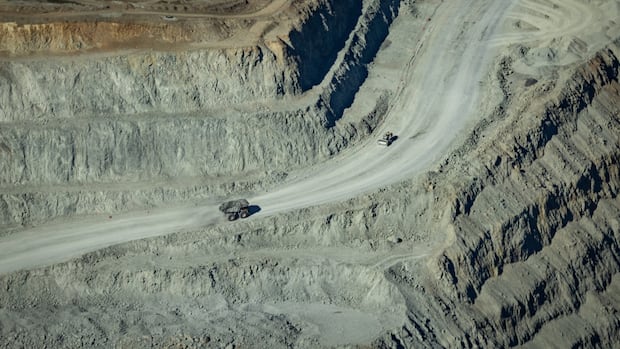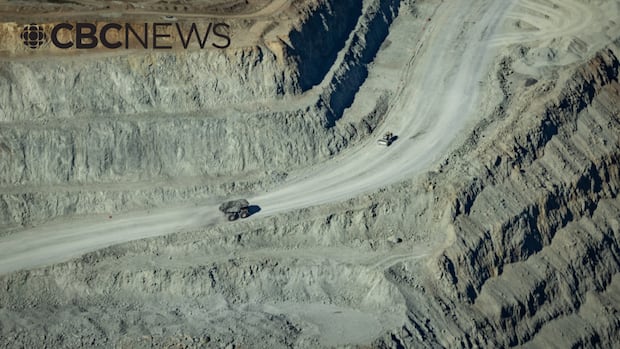[
A remote-controlled scoop has begun the work of removing a pile of debris 20 to 30 metres long and seven to eight metres high to gain access to three workers trapped at the Red Chris mine in northern British Columbia, a company statement says.
Newmont Corp. said Thursday that specialized drones have been sent in to assess the geotechnical conditions underground.
“The area of the refuge chambers is not in the same area as the fall of ground and is understood to be stable and well-ventilated,” the company said of the location where the three workers are holding out.
Teams are restoring a specialized communication system to try to re-establish communication with the workers, the statement said.
A rescue operation is underway to retrieve three miners trapped underground in northwest B.C. The miners work at the Red Chris mine on Tahltan Nation territory near Dease Lake, B.C., about 420 kilometres west of Fort Nelson. The CBC’s Meera Bains has more on the efforts to bring the workers at the open-pit copper and gold mine to safety.
The workers were trapped Tuesday after two rockfalls at the mining site, located on Tahltan Nation territory near Dease Lake, B.C., about 420 kilometres west of Fort Nelson, B.C.
Premier David Eby initially said two of the workers are from B.C. and one is from Ontario, but their contractor, Hy-Tech Drilling, said Thursday that one is from B.C., one is from Ontario and one is from Manitoba. Hy-Tech said the workers are diamond drillers, meaning they cut through rock using drill bits embedded with industrial diamonds.
Refuge chamber equipped for 16 people
Newmont said the three are in a refuge chamber with enough air, food and water for an extended stay, although their communication was cut off after the second cave in.
“The workers are understood to be sheltering in a MineARC refuge chamber designed to support 16 people. Additional refuge chambers are also available nearby and accessible if required,” Newmont said Thursday.
Production at the gold and copper mine has been paused while the rescue effort continues.
The mine is mostly open pit, but Newmont said in an earlier statement that development of underground block-cave mining began in 2019, four years after the mine’s first production date.
They were working more than 500 metres past the affected zone when the first rocks fell, and were asked to relocate to the refuge before the second fall.
“Following the first event, contact was established with the individuals and confirmation was received that they had safely relocated to one of multiple self-contained refuge bays,” the company said.
Workers around 600 metres inside tunnel: source
A source with direct knowledge of the mine and the rescue operation said the first fall of ground happened 200 metres into a lateral tunnel underground.
The source said the mine workers were 400 metres beyond that, meaning they were around 600 metres inside the tunnel.

According to the source, there has been no contact with the mine workers since the second fall of ground, but it did not impact the area where the three workers sought refuge.
The source said there were multiple self-contained refuge bays in the area, with each having enough supplies to sustain 16 people for three days.
A statement from Hy-Tech Drilling, a Smithers-based company that works with mining companies around the world, confirmed the three contractors were that company’s employees but that it would not be releasing the workers’ names out of respect for their privacy.
B.C. Premier David Eby said on Wednesday that there was an accident at the Red Chris mine in northwest B.C., where three miners are trapped underground. Eby added that, to the best of his knowledge, they are not injured. (NOTE: The premier initially said the incident occurred overnight, in fact the incident happened earlier Tuesday.)
Nolan Paquette, a local vice-president with the United Steelworkers Local 1-1937 — which represents about 450 Red Chris workers — said the three workers are boring a hole to start up “block-cave operations” at the mine within the next three years.
The open-pit mine, which is above ground, is transitioning to underground mining using “block caving,” a technique that involves digging underground to target the ore from below, according to a Newmont communications video on the company’s website.
Dwayne Tannant, a geotechnical engineering professor with the University of British Columbia, says the rescue could take time as it can’t be rushed.
“You don’t want to be sending people over … scrambling over the material because more stuff could come down,” he said.
UBC professor of geotechnical engineering Dwayne Tannant shares insights on the conditions faced by the three trapped miners inside the Red Chris mine refuge station.
“It’s safety first, that’s the highest priority, safety of the people re-establishing the tunnel. So they’ll be very systematic about bringing the right equipment, bringing the right personnel with experience to stabilize the tunnel, probably putting in rock support.
“And I suspect they’re going to have to then pull out the debris, and they’ll do that in a series of stages and advance through the area where the tunnel has collapsed.
“That could take days,” Tannant said.
The Red Chris mine is one of the projects that B.C. announced it would be fast-tracking in response to the U.S. tariff threat.
Newmont CEO Tom Palmer said during the company’s second quarter earnings call on Thursday that it plans to investigate what took place.
“We are concentrating the full force of our organization on the safe recovery of our team members at Red Chris and we will conduct a thorough and independent investigation into the factors that led to this event,” Palmer said, adding that any findings will be used across the company and shared with the broader mining industry.



